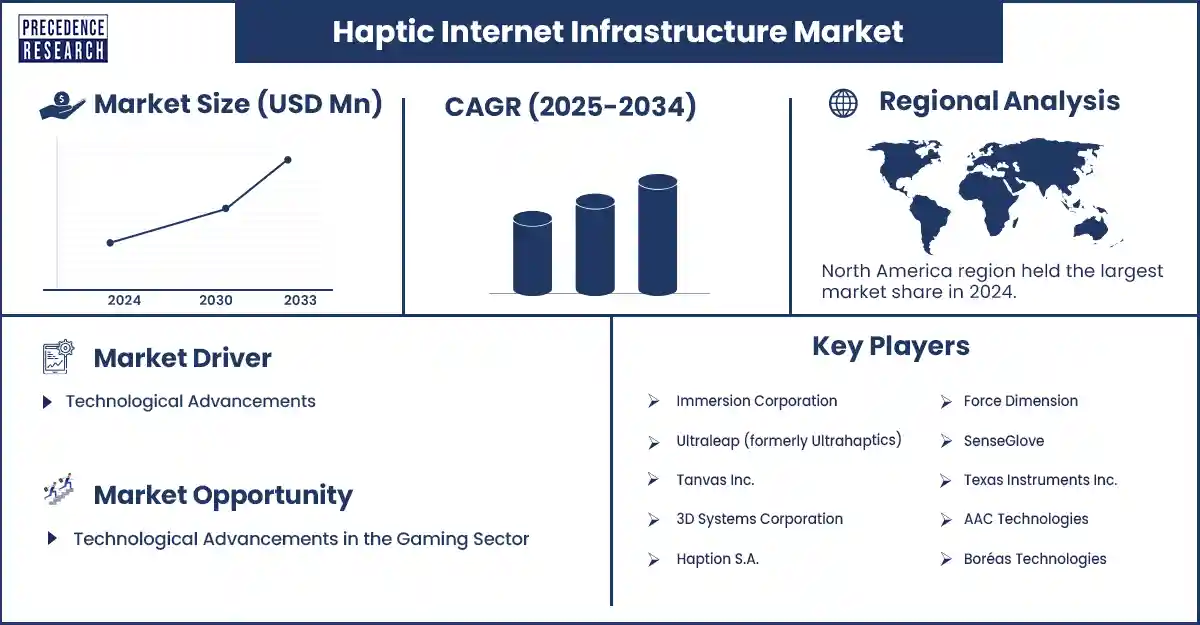Haptic Internet Infrastructure Market Revenue and Forecast by 2033
Haptic Internet Infrastructure Market Revenue and Trends 2025 to 2033
The global haptic internet infrastructure market growth is fueled by advancements in 5G, edge computing, and ultra-low latency networks. The market is expanding rapidly because users and industries are increasingly demanding immersive, low-latency touch feedback for remote interactions. The rising adoption of AR/VR, telemedicine, and robotics is also driving investment in haptic internet infrastructure.

Market Overview
The haptic internet infrastructure market is experiencing significant growth, driven by several factors. The rise of applications incorporating virtual, augmented, and extended realities in gaming, remote work, and training creates a significant need for network architecture that can support sub-millisecond latencies and precise tactile sensation. Demand in healthcare and telehealth is also driving the need for infrastructure to enable remote surgery, rehabilitation, and medical education with a high-fidelity touch experience. Advancements in actuator and sensor technology, including piezoelectric and electroactive polymers, along with high-resolution tactile sensors, have increased the affordability and reduced power requirements for integrating haptics into a wide range of applications and devices.
Segment Insights
- By component type, the network infrastructure segment dominated the market in 2024, as real-time haptic data transfer requires ultra-low latency, high bandwidth, distributed edge nodes, and reliable connectivity.
- By technology type, the tactile feedback systems segment dominated the market with a major revenue share in 2024, as most applications require only vibration, texture, or touch sensations rather than force feedback. The growing demand for immersive user experiences across various sectors, including healthcare, gaming, automotive, and remote operations, further bolsters the segment.
- By application sector, the healthcare & telemedicine segment led the market in 2024. This is mainly due to the rapid adoption of remote surgical procedures, virtual diagnostics, and haptic-enabled medical training. These applications rely heavily on real-time tactile feedback and ultra-low latency communication to ensure precision, safety, and effectiveness in patient care.
- By deployment model, the cloud-based infrastructure segment maintained dominance in the market due to its flexibility, scalability, and cost-efficiency.
- By end-user profile, the enterprise customers segment contributed the largest share of the haptic internet infrastructure market in 2024. This is mainly due to the increasing adoption of haptic technologies across industries such as healthcare, manufacturing, automotive, and defense. Such enterprises adopt haptic systems by investing in robust infrastructure to improve productivity, safety, training, or consumer experience.
- By quality & performance tier, the standard latency (1–10 ms) commercial solutions segment dominated the market, as these solutions provide the optimal balance between performance and cost for most real-world applications.
Regional Insights
North America dominated the haptic internet infrastructure market while holding the largest share in 2024. This is mainly due to its robust infrastructure, significant investments in 5G/6G and edge computing, and early adoption of advanced technologies. The region is home to a large number of market players. There is a high demand for immersive applications. The healthcare sector in the US, in particular, has shifted toward remote surgery, telemedicine, and training simulators. All these factors support North America’s dominance.
Meanwhile, Asia Pacific is expected to grow at the fastest rate in the coming years. This is primarily due to rapid digital transformation, increasing investments in 5G and next-generation connectivity, and rising demand for advanced technologies across industries. Countries like China, Japan, South Korea, and India are actively developing smart infrastructure, expanding healthcare access, and adopting immersive technologies in education, manufacturing, and entertainment.
Haptic Internet Infrastructure Market Coverage
| Report Attribute | Key Statistics |
| Quantitative Units | Revenue in USD million/billion, Volume in units |
| Largest Market | North America |
| Base Year | 2024 |
| Regions Covered | North America, Europe, Asia-Pacific, Latin America, and Middle East & Africa |
Recent Development
- In August 2024, InterDigital published a white paper in collaboration with Futuresource. The report highlights haptics as an emerging core media type alongside audio and video. By 2028, over half of all connected devices are expected to feature haptic technology, enhancing digital experiences through touch. (Source- https://csimagazine.com)
Get this report to explore global market size, share, CAGR, and trends, featuring detailed segmental analysis and an insightful competitive landscape overview @ https://www.precedenceresearch.com/sample/6782
You can place an order or ask any questions, please feel free to contact at sales@precedenceresearch.com |+1 804 441 9344